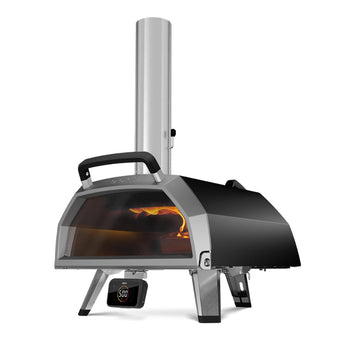Good pizzas are built on good dough.
Whether it’s chewy, fluffy or crackly, your pizza crust makes or breaks the eating experience. That’s why it’s important to dial in your dough recipe.
You can use guidance from cookbooks and chefs, of course, but if you want to develop a formula that’s precisely to your taste, you’ll need to keep records of what works and what doesn’t.
Enter the dough log.
Simply put, it’s a notebook filled with kitchen experiments and past bakes.
A dough log lets you keep a record of hits, misses, delightfully springy surprises and overproofed flops.
Best of all, when you finally hit on that exact right combination of crunch, chew, bite and snap, you’ll know how to recreate it.
We spoke to a couple of pizza-making obsessives — pizza cookbook author and Rosehill Sourdough owner Mike Vaona and Unholy Pizza blogmaster and Ooni Experience Manager Lewis Pope — about perfecting pizza dough (specifically what they’ve tracked to get there).
Hint: the tips involve recipes, riffing and keeping track of what you’re doing very carefully (psst — Mike’s an engineer).
Baker’s Math
Both Mike and Lewis approach pizza making like scientists (well, scientists who love cheese and gluten).
For starters, they use baker’s math to write recipes.
In lieu of trying to double and halve recipes, Mike and Lewis note percentages of flour, water, yeast, salt and other ingredients.
This makes it easy to keep track of the recipes they’re writing, so that they can scale any recipe up for a party or down for a weeknight family dinner.
Accuracy
They both also use a digital scale when making dough and keep track of ingredients in grams.
Working with a scale instead of cups or tablespoons helps them recreate recipes perfectly every time.
If you’re not sure why grams are more accurate than cups, consider this: King Arthur Flour and Cook’s Illustrated recipes have a 20-gram difference between the amount of flour listed in a cup! (Check out our primer on how to use a digital scale for some great tips.)
Environment
Mike and Lewis keep track of their environments.
No, they don’t wear white coats and make pizzas in sterile labs, but they do take into account some things about where they’re baking.
Bread contains yeast, and yeast gets more active when it’s warm and less active when it’s cold.
Lewis looks at a thermometer in his kitchen when mixing up a batch of dough and uses that temperature to help him figure out how much yeast he needs and how long the dough will take to proof.
Mike’s method is a little different: he takes the temperature of his raw ingredients before mixing and then takes the final dough ball temperature before proofing.
Date your recipes
It can be really fun to track your own personal journey through pizza.
Consider dating your dough log entries so that someday down the road, you can look back and reflect on your own personal development as a pizza maker.
At least, that’s what Ooni’s Head of Pizza Content Arthur Bovino maintains.
“It’s nice to be able to remember when and how you learned the things that eventually led you to your ideal dough, or sent you down different paths altogether.”
Take photos
Speaking of dates, using them on dough log entries makes finding photos of your dough (and resulting pizzas) on your phone much, much easier!
“Quick photos on your phone can serve as a great visual and digital dough log that can help prime your memory when you’re working on improving your dough — whether you make pizza every week or every few months,” Bovino notes.
TL;DR
It’s easy to get in the weeds when talking about math, percentages and yeast.
Whether you’re familiar with the tips we’ve shared or you’re feeling slightly bewildered, the important thing to remember if you’re going to start making your own dough is just to start observing.
Need some guidance on what exactly to observe?
Here’s a tried-and-true list of things Mike writes down every time he tries a new recipe:
- The recipe formula in percentages
- The weight of each ingredient
- The type of flours used (the particular brand can be helpful to note as well)
- Mixing implement (by hand or by mixer)
- Length of mixing time
- Temperatures of the water, flour, sourdough starter (if applicable) and final dough
- The time it went into and came out of the fridge (if applicable)
- The time when the dough was balled after the bulk proof
- The time when the actual pizza was made
- General notes: felt wet, felt dry, too soft, too tough etc.
- Tasting notes: chewy, crunchy, springy, sour, yeasty, puffy etc.
You might not use all of these factors in your own process, but this list is a good place to start when you begin your dough log journey!








